What is white tongue disease? White tongue disease is a condition where you see a grayish white layer covering the surface of the tongue. It is often accompanied by bad breath, which can make the person feel self-conscious and hesitant to interact with others.
So what exactly is white tongue disease? What are the causes and how is it treated? Let’s take a look at the detailed information in the following article from Bedental.
What is white tongue disease?
What is white tongue disease? White tongue disease is a term used to describe any area of the tongue that has a white or off-white coating, also known as white furry tongue. This can cause confusion and misunderstanding as to what white tongue actually is. White tongue disease is usually a harmless condition, with mild and easily treatable characteristics.
However, there are times when a white tongue can also be a symptom of underlying conditions that require examination and treatment by a specialized doctor.
See more: What is tongue scraping? 10 things you need to know
Signs that indicate you have white tongue disease.

White tongue disease, or also known as oral thrush, is a common condition that can be easily identified by the following symptoms:
- White or yellow tongue: One of the most common signs of white tongue disease is the formation of white or yellow patches on the tongue. These patches can vary in size and shape, ranging from small spots to larger patches.
- Raised bumps: White tongue disease can cause raised bumps or sores in the mouth, including the tongue, palate, and other areas of the mouth.
- Mouth pain: Mouth inflammation can result in discomfort or pain in the mouth.
- Bad breath: If white tongue disease is caused by bacteria or yeast, you may notice that your breath has an unpleasant odor.
- Loss of sensation or discomfort in the mouth: White tongue disease can cause loss of sensation or discomfort in the mouth, including the tongue and other parts of the mouth.
See more: Remove wisdom teeth
Causes of white tongue disease
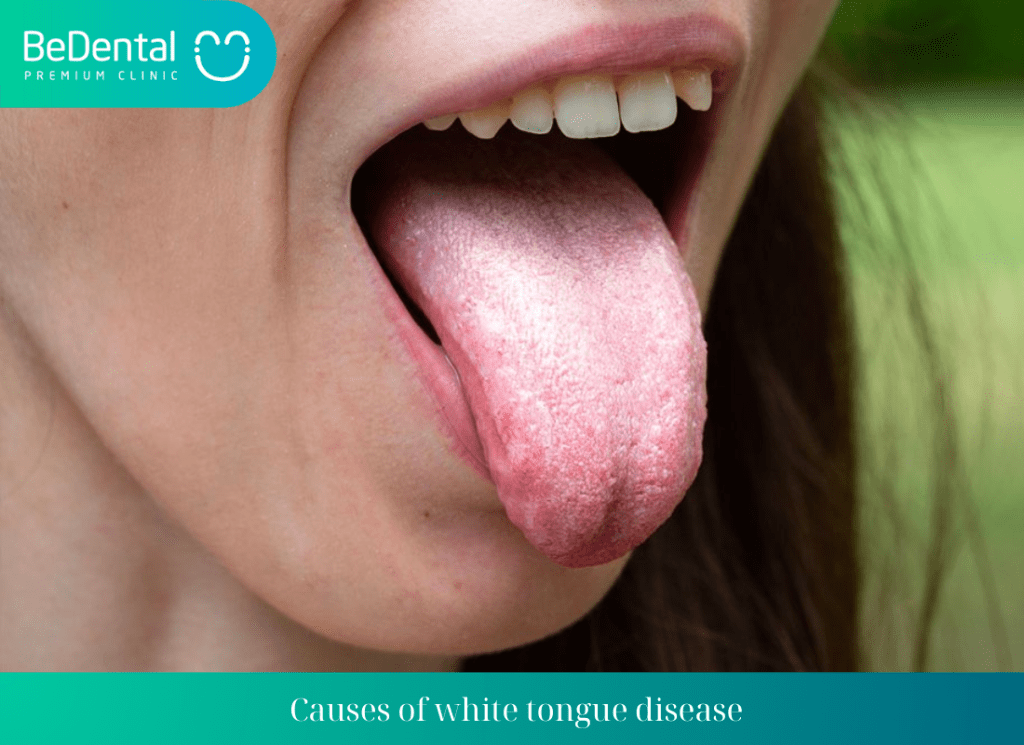
Poor oral hygiene
The majority of people with white tongue disease have poor oral hygiene habits. They do not have the habit of regularly caring for their oral health.
On the surface of the tongue, there are many swollen and infected areas caused by bacteria and dead cells that are not properly cleaned in the oral cavity. All of these factors combine to form a white coating on the surface of the tongue. This white coating can be easily observed with the naked eye.
The solution to white tongue caused by poor oral hygiene is to actively maintain good oral hygiene practices. Brush your teeth twice a day. You can also use mouthwash. Proper brushing techniques can help keep your teeth and gums clean. Additionally, it helps reduce bad breath, making you more confident in your daily communication.
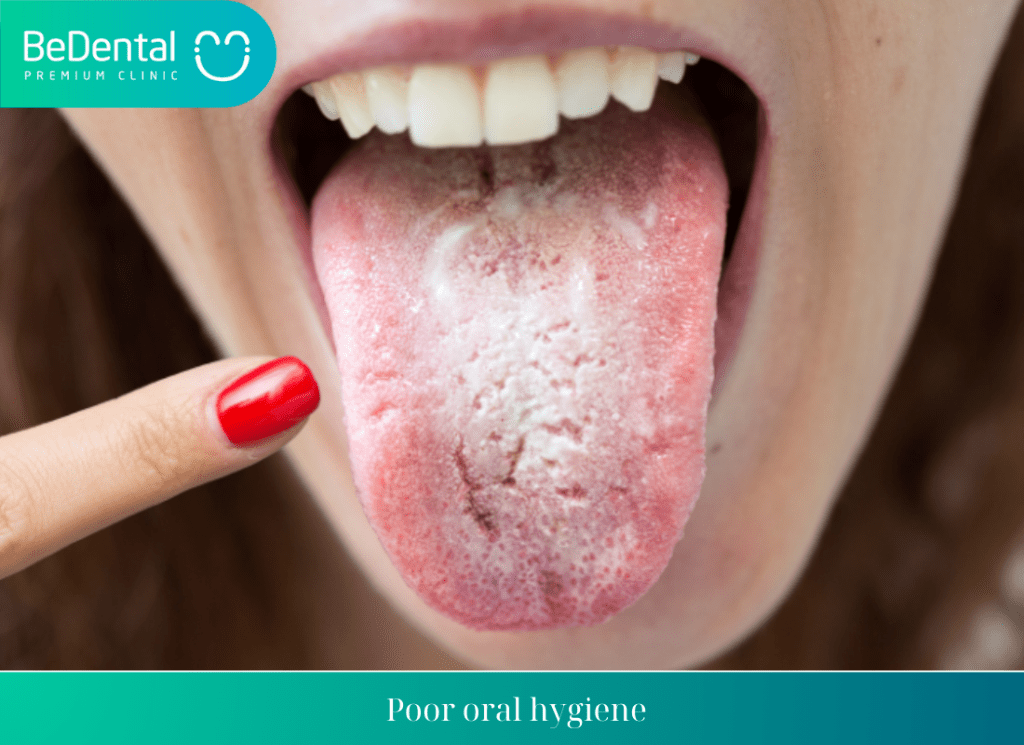
Due to oral lichen planus
If you take good care of your oral hygiene but still have a white tongue, it is likely that the cause is oral lichen planus. Lichen planus is a type of oral inflammation that causes thick, white patches to appear in the mouth and on the tongue.
Oral lichen planus not only presents with a white tongue, but also with other symptoms. These may include cheek pain, ulceration, tongue swelling, gum swelling. To treat oral lichen planus, you should see a doctor for examination. Doctors will provide safe and appropriate treatment options.
Oral thrush
Oral thrush, also known as candidiasis, is a common cause of white tongue. Candida, a type of yeast, often enters the mouth through close contact with an infected person or through contaminated food.
Once in the body, the yeast grows and forms white patches in the mouth and on the tongue. These white patches may appear pale or milky white. White tongue caused by candida can also cause bad breath. Some individuals may experience pain, loss of appetite, and increased saliva production.
White tongue is commonly seen in individuals with weak or compromised immune systems. Those undergoing cancer treatment or taking daily antibiotics are also susceptible to white tongue. In these cases, antifungal medications such as inhaled corticosteroids can be used to eliminate the yeast.
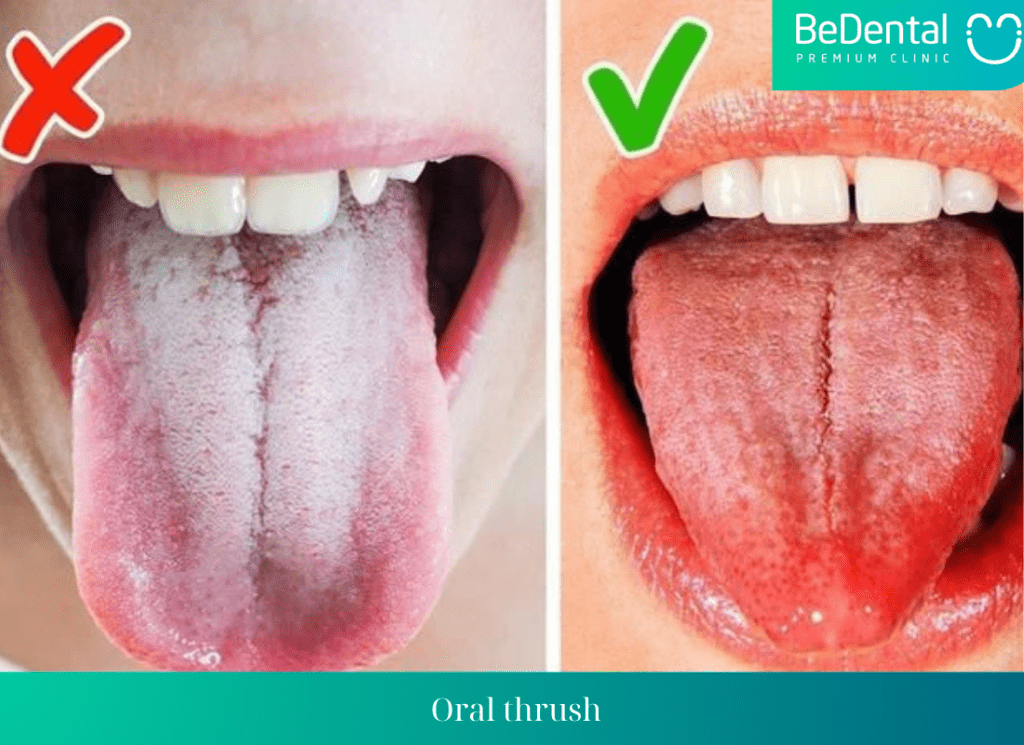
Leukemia
Leukemia is also one of the causes of a white tongue. When a patient has leukemia, symptoms such as white patches tightly adhered to the surface of the tongue will appear.
Therefore, a white tongue is also an early warning sign that you may have leukemia. It is important to go to the nearest healthcare facility for examination and timely treatment according to the doctor’s instructions.
Vitamin deficiency
We cannot deny the importance of vitamins for human health, especially vitamins B9 and B12. The appearance of a white tongue accompanied by bad breath is likely to occur if you do not pay attention to daily vitamin supplementation, leading to a deficiency of important vitamins in the body.
Signs of vitamin deficiency include a pale tongue, a consistently dry and hard mouth, especially in winter when the cold weather requires the immune system to expend more energy to keep the body warm.
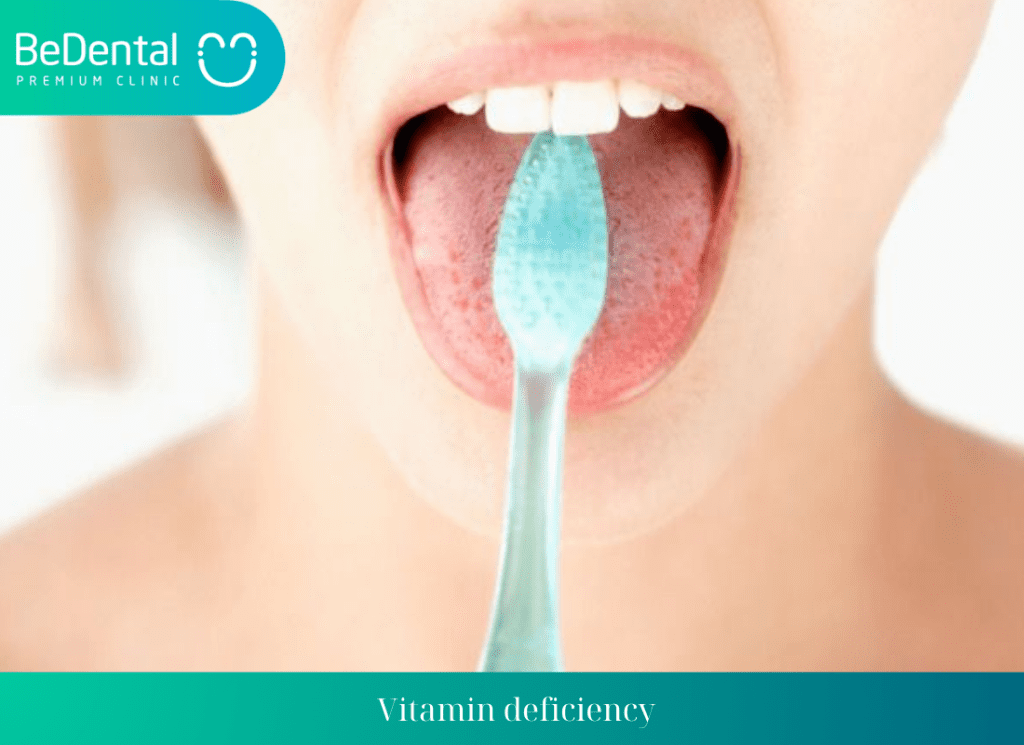
Gastric reflux
Gastric reflux is caused by excess stomach acid or weak esophageal sphincter muscles, as well as an excessive amount of food in the stomach.
You will easily feel the stomach fluid being pushed back up into the throat, causing a painful and irritated sensation, mucosal damage, discomfort, and a foul odor. Over time, your tongue will develop thick white patches, causing discomfort.
Oral infections
Originating from soft tissue injuries in the oral cavity. Most cases of infection will resolve within 2 weeks.
The presence of a white tongue accompanied by bad breath is a warning sign that you may have an infection or oral thrush. When infected, you may experience pain while eating or drinking, loss of taste, constant fatigue, and weakness.
If you have all the above symptoms, it is important to take proactive care of your oral health and undergo regular check-ups to detect any early signs of abnormalities.
Other causes
In addition to the mentioned causes, white tongue can also result from the following:
- Not drinking enough water, leading to severe dehydration.
- Breathing through the mouth and sleeping with the mouth open.
- Respiratory tract infections.
- Regularly using harmful substances such as alcohol and tobacco.
- Lack of tongue hygiene.
- Irritation of the tongue’s mucous membrane due to dentures, braces, or damaged teeth.
Knowing the causes of white tongue will guide you towards proper treatment. Each cause requires a different treatment approach.
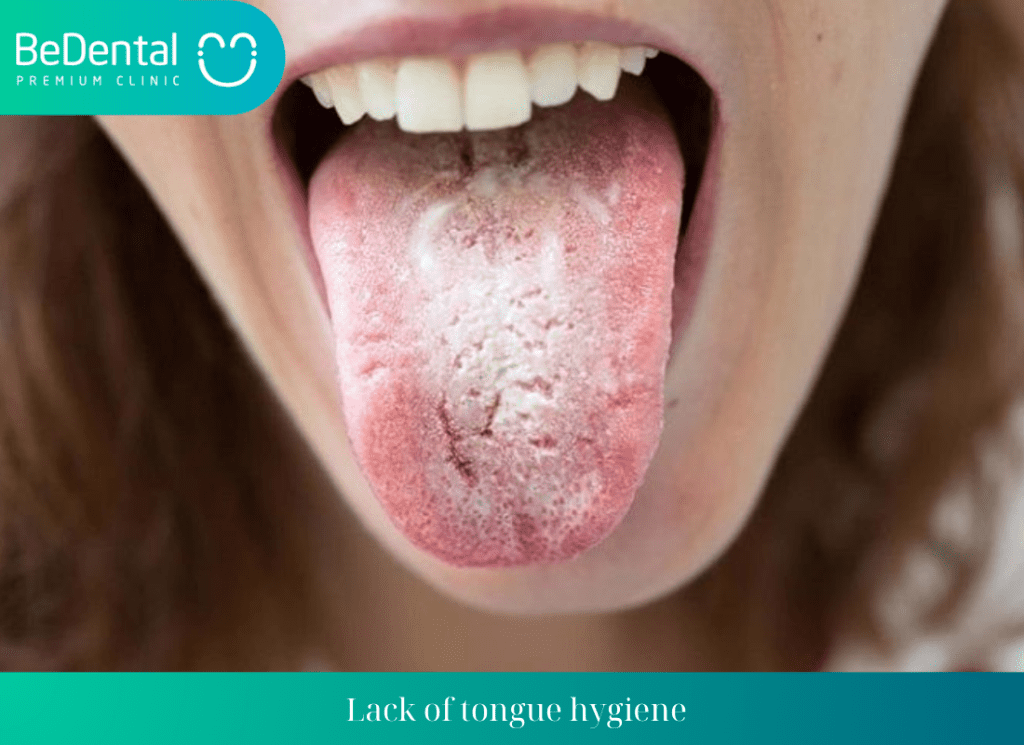
Treatment for white tongue
The treatment for white tongue starts with improving oral hygiene. Pay more attention to taking care of your oral health. To remove white patches on the tongue, gently brush the surface of the tongue with a toothbrush.
If the buildup is too thick, you can use a specialized tongue scraper to remove the buildup more effectively.
In your daily routine, make sure to drink plenty of water to keep the mouth hydrated. This habit not only helps detoxify the body but also limits the growth of bacteria in the oral cavity, preventing white tongue.
If, after maintaining good oral hygiene habits for a while, the condition of white tongue does not improve, it is recommended to seek medical attention. This will allow for further examination and diagnosis to determine if there are any underlying conditions.
White tongue due to oral lichen planus
For cases of white tongue due to oral lichen planus, regular oral hygiene is important. Pay attention to proper brushing techniques and clean the tongue daily. In severe cases of oral lichen planus or if home remedies do not alleviate the condition, mouthwashes or sprays containing steroids can be used for treatment.
White tongue due to oral thrush
For cases of white tongue due to oral thrush, antifungal medications are used for treatment. These medications come in various forms such as liquid, oral gel, tablets, or lozenges and can be found at pharmacies nationwide. It is advisable to consult a doctor to determine the most appropriate treatment method.
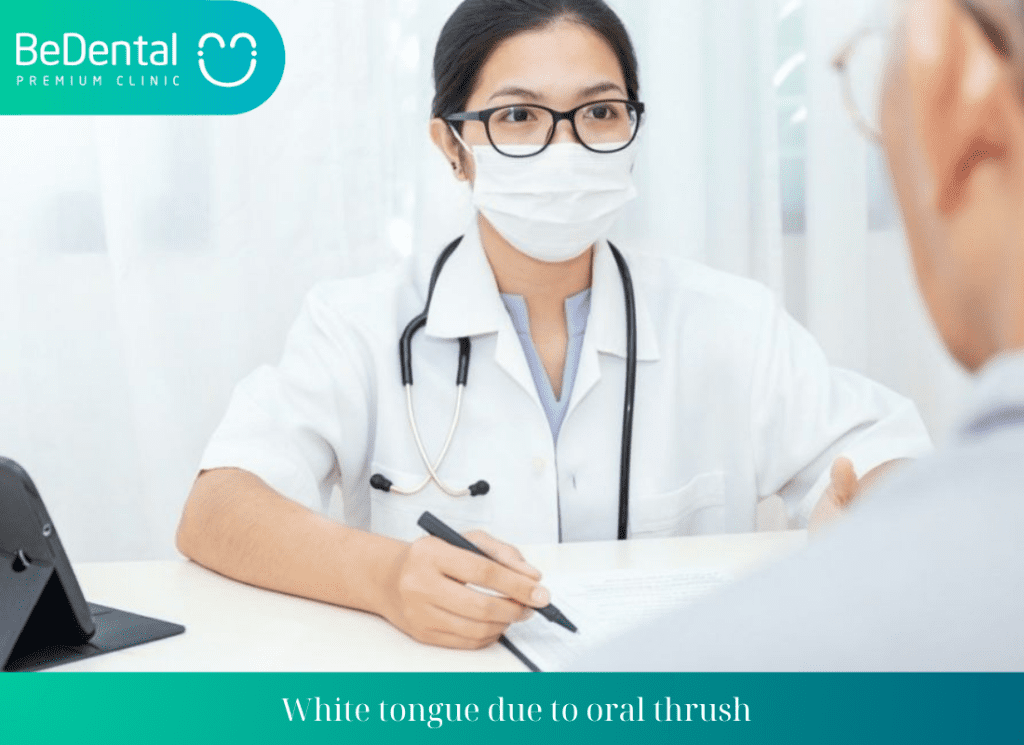
Building a balanced diet
Adopting a scientific and balanced diet is one of the effective methods to prevent white tongue and bad breath.
Follow a diet that includes cooked food, boiled water, and sufficient intake of vitamins and minerals for the body every day. Minimize the consumption of canned foods, deep-fried foods, and harmful stimulants.
Regular dental check-ups
Make it a habit to have regular dental check-ups to get your teeth cleaned. Dentists will examine and detect any abnormalities in the gums and tongue, allowing for timely treatment before it’s too late.
See more: Causes of bitter taste in mouth
Don’t worry too much about the cost of dental cleaning. This method is quite common and is applied by dental clinics at reasonable prices.
Bedental is a reputable dental clinic and one of the trusted addresses for dental and facial treatment in Vietnam. Bedental not only specializes in treating dental and facial conditions but also excels in cosmetic dentistry.
At Bedental, you will experience services in a reputable and modern dental clinic. Alongside highly skilled and dedicated dentists, who wholeheartedly serve patients.
Easy-to-use tongue cleaning tools
Clean your tongue with a toothbrush.

Although tongue scraping is not as convenient and easy to perform as brushing, it is still widely used by many people. Here is how to do it:
Perform tongue scraping as follows:
- Choose a toothbrush with soft bristles.
- Stick your tongue out to make it easier to scrape.
- Place your toothbrush at the back of your tongue.
- Gently scrape forward and backward along your tongue.
- Spit out saliva and rinse the toothbrush with warm water.
- Gargle with clean water or mouthwash.
See more: Interdental caries
Tongue cleaning should be done regularly when you brush your teeth, at least once a day. You can use a mixture of 1 part hydrogen peroxide and 5 parts water to cleanse your tongue if it changes color.
Cleaning white tongue with a tongue scraper
A tongue scraper is a tool specifically designed to remove plaque from the surface of the tongue. When using a tongue scraper for the first time, you may feel discomfort and nausea. This is a natural reflex when external force is applied to the tongue. Don’t worry, as the discomfort will gradually disappear after a few times of using the tongue scraper.
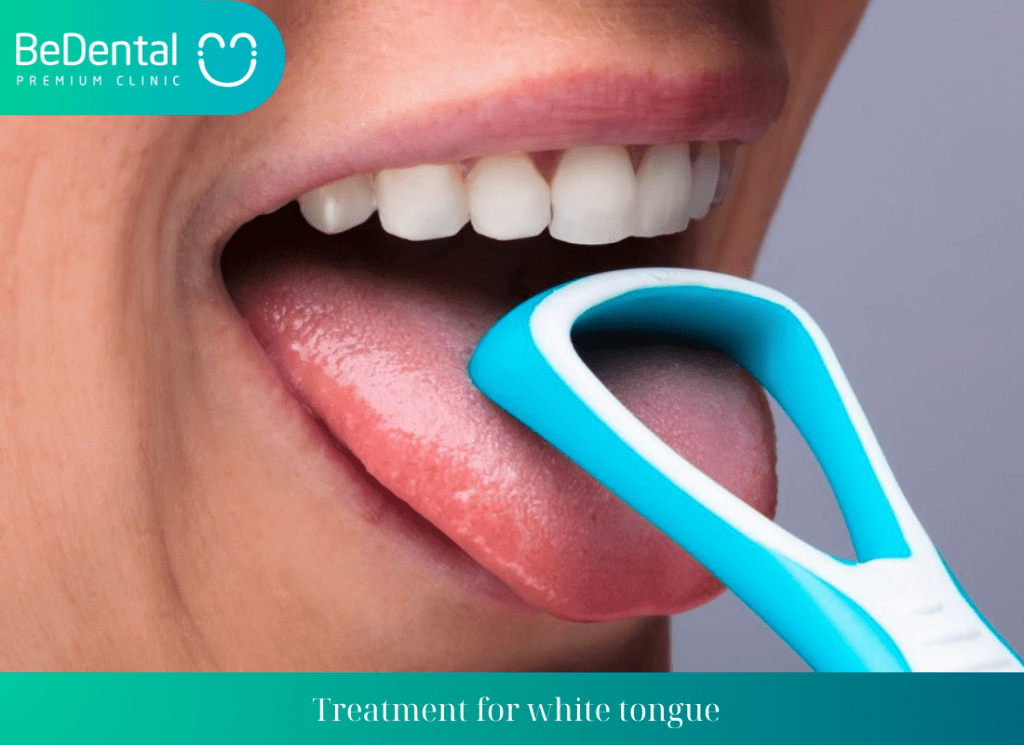
Tongue scrapers are becoming more popular than ever, and you can buy them at pharmacies, bookstores, and drugstores. There are many types of tongue scrapers available for you to choose from according to your preferences. The steps for tongue hygiene are as follows:
Step 1: Stick out your tongue as needed
Many women tend to put the tongue cleaner inside their mouths without sticking out their tongues. This will not thoroughly clean the tongue, so when cleaning the tongue, you should stick out your tongue as much as possible.
Leave the surface of the tongue exposed to ensure effective cleaning. Additionally, sticking out the tongue completely will help you avoid feeling nauseous during tongue cleaning.
Step 2: Insert the tongue scraper inside
The deep inner part of the tongue contains a lot of odor-causing bacteria, so don’t overlook this area. Gently insert the tongue scraper into your mouth and scrape slowly.
See more: Betadine Mouthwash
After the first scrape, rinse your mouth to wash away the scraped debris and continue scraping until there are no white patches on the tongue. When scraping the tongue, be gentle to avoid scratching it.
Step 3: Rinse your mouth
Mouthwash and saltwater can help wash away the debris on the tongue. So after cleaning your tongue, don’t skip the step of rinsing your mouth. Use your tongue to swish mouthwash around your mouth to remove any remaining debris.
Here are a few points to note when tongue scraping:
- You don’t need to apply excessive force while scraping, which can cause discomfort. Be careful with your tongue. Applying too much pressure won’t increase the number of bacteria, but it will cut down on the cleaning you need to do. Just use a little pressure, and you can clean the dirt on the tongue.
- Tongue scraping is not the only method to treat bad breath. Although having a tongue coated with white residue can contribute to bad breath, it is not the sole reason for it.
- If you’re concerned about bad breath, you should also consider using odor-reducing foods, maintaining good oral hygiene, and checking other factors. Tongue scraping can help reduce bad breath.
- Stick to basic tools. There are many complex tongue scraping tools available online, but they are not necessary. All you need is an effective and affordable tongue scraper. Digital tongue scrapers can make your life simpler, but they come at a higher cost.
- Perform tongue scraping every morning. As soon as you wake up, your tongue is covered in a white-colored film. Therefore, it’s important to scrape your tongue right away. The morning is the most suitable time for oral care!
Clean your tongue with mouthwash.

Mouthwash – especially when used in conjunction with toothpaste – can help clean your tongue and the inside of your mouth.
Consider choosing an herbal mouthwash that contains antifungal agents to remove toxins from your mouth that can cause bad breath and health issues.
You can purchase mouthwash products from reputable shopping platforms. Alternatively, you can ask your doctor or dentist to prescribe one for you. Following the instructions for mouthwash will help protect your oral health effectively.
Notes on tongue cleaning
Following the above instructions completes the tongue cleaning process. However, while cleaning your tongue, do not overlook the following tips!
Replace or clean the tongue scraper
Similar to toothbrushes, tongue cleaning tools should be thoroughly cleaned or replaced every day and replaced every 3 months. This also prevents the accumulation of bacteria in the cleaning tools.
Use gentle force
The tongue is a sensitive area and can be easily scratched, so when scraping your tongue, be careful to scrape gently and use just enough force to remove dirt without scratching or causing the tongue to bleed.
See more: Understanding canine teeth
Maintain regularity
You should also scrape your tongue twice a day, in the morning and evening before brushing your teeth. If you do not regularly clean your tongue, microorganisms will continue to accumulate on the surface of the tongue and affect oral health-related conditions. Therefore, you need to clean your tongue every day.
For more information, consult additional sources.
Tư vấn chuyên môn bài viết:
BÁC SĨ DƯƠNG THỊ THÙY NGA
Bác sĩ chỉnh nha tổng hợp
Ngôn ngữ giao tiếp: Tiếng Việt, Tiếng Anh, Tiếng Nga
Đặt Lịch Hẹn
Xem Hồ Sơ
Tư vấn chuyên môn bài viết:
BÁC SĨ DƯƠNG THỊ THÙY NGA
BEDENTAL - TOP STANDARD DENTISTRY SYSTEM
In HANOI
Address 1: 7B Thi Sach St, Ngo Thi Nham, Hai Ba Trung Dist, Ha Noi. - 0934.61.9090
Address 2: No 129 Hoang Ngan, Yen Hoa, Cau Giay Dist, Ha Noi. - 0934.61.9090
In HO CHI MINH
Address 1: 53 -55 -57 Pho Duc Chinh St, Nguyen Thai Binh, Dist. 1, Ho Chi Minh. - 0766.00.8080
Working: 9am - 8pm everyday
Website: https://bedental.vn/en/





